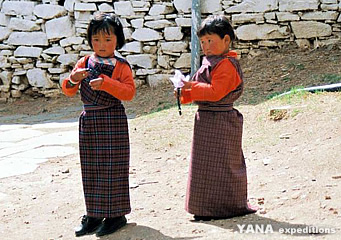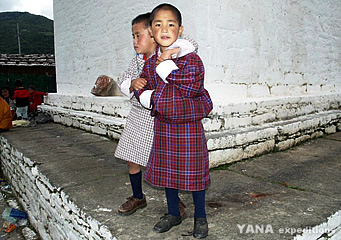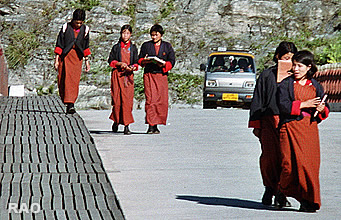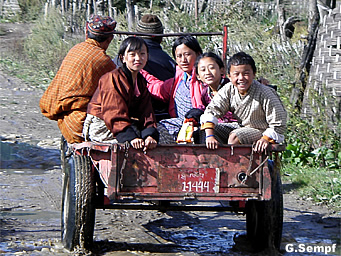 |
Bhutan's
Education |
|
 |
Bhutan's
Education |
|
|
 |
|
UNICEF:
Girls enrollment lagging behind
|
 |
 |
| Bhutan
is among 25 countries worldwide that failed to meet the Millennium Development
Goal of achieving gender parity in primary and secondary education by 2005,
according to the Gender Achievements and Prospects in Education report
released by the United Nations Children's Fund (UNICEF).
The
'25 by 2005' acceleration campaign designed by UNICEF to intensify efforts
in 25 countries which fall behind deadline includes countries mostly in
South Asia and Africa.
The
countries were selected based on one or more of the criteria that defined
the country's drawbacks in achieving the goals. |
|
| Disparity
among schools? |
 |
While
government has always stressed on quality education for children in a conducive
environment - with adequate sanitation, safe drinking water, well-ventilated
rooms - many schools in Thimphu fall far behind in fulfilling the criteria.
Crowded
classrooms, inadequate sitting space, broken blackboards and a run down
school building are a common sight. Too often schools have poor drinking
water facility with sanitation in deplorable conditions. Some schools like
Changzamtog Lower Secondary School run shifts to adjust the high number
of students in the primary section.
|
On
the contrary, some schools in the capital are the envy of everyone. Well-maintained
buildings, manicured gardens with better sanitation facilities and better
equipped classrooms which spell out the obvious imbalance in the distribution
of infrastructure facilities among the schools.
Although
education officials agreed that some schools in the capital needed attention,
they denied the allegation that disparity existed among the schools. They
said that some schools had lagged behind in development activities because
"of the plans to shift the location". |
 |
The
officials also said that the responsibilities also lie with the faculty
and the administration of the schools. "Efforts have to be made by the
administration division by highlighting problems to the dzongkhag authorities,"
said the education spokesperson, adding that the ministry had already taken
action in some cases.
The
report states that with net enrollment ratio of 50. 7 percent, only half
of the total children in Bhutan are enrolled in primary school. The net
enrollment rate for boys, at 53.3 percent was higher than the enrollment
rate for girls at 48.0 percent.
 |
| The
report highlights that Bhutan stands next to Afghanistan in the region
and faces the second highest required average annual rate of increase to
meet the goal by the final deadline of 2015.
The
report, however, points out that 'lack of reliable data' in Bhutan makes
it difficult to assess progress in the field.
Agree
education officials. The officials said that the data reflected in the
report could neither be denied nor accepted because of the lack of proper
figures. |
|
"Only after the exact population figures are in place can we get
the proper picture of where we stand," said the school education director,
Tshewang Tandin.
A
UNICEF official observed that data always varied when it came to Bhutan
as every calculation was based on the previously projected population figure
of 2.1 million with the UN that is yet to be updated.
Although
there is a general consensus that still more needs to be done to bridge
the gap, education officials said that Bhutan is not far behind. The gross
primary enrollment, according to education ministry's general statistics
book, has made considerable progress from 55 percent in 1990 to 84 percent
in 2004. The girls, however, surpassed the boys in the enrollment growth
in primary education with a growth rate of 5.6 percent to that of 3.4 percent
growth rate for boys.
Among
the SAARC countries, Sri Lanka had already achieved universal education
while Maldives was fast on track. But India, which accounted for 23 percent
of global absentees, had about 26.8 million primary school-age children
left out on education.
Pakistan
and Bangladesh followed behind with seven and three percent of the total
children not in school.
The
report states that gender parity in education is a 'far-off' destination
in more than half of the eight countries in the region. A total of 23.5
million girls in South Asia were out of school. |
|
 |
According
to the report, universal education depends on an infrastructure that supports
quality education which goes beyond the physical structure of a building
or the classroom content.
"Quality
education is lost when children are jammed into classrooms with insufficient
textbooks and untrained teachers," the report states.
| Contributed
by Karma Choden,KUENSEL, Bhutan's National Newspaper, 2004 |
 |
|
Links |
 |
 |
 |
External
links |
|






